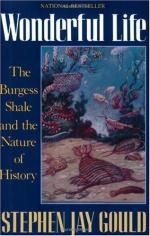|
This section contains 504 words (approx. 2 pages at 400 words per page) |

|
Wonderful Life: The Burgess Shale and the Nature of History Summary & Study Guide Description
Wonderful Life: The Burgess Shale and the Nature of History Summary & Study Guide includes comprehensive information and analysis to help you understand the book. This study guide contains the following sections:
This detailed literature summary also contains Topics for Discussion and a Free Quiz on Wonderful Life: The Burgess Shale and the Nature of History by Stephen Jay Gould.
Wonderful Life: The Burgess Shale and the Nature of History focuses on a limestone quarry high in the Canadian Rockies known as the Burgess Shale. The Burgess Shale formed 530 million years ago and contains fossils of creatures from an incredibly ancient sea, where a plethora of frighteningly alien creatures lived and died. Stephen Jay Gould, the famous paleontologist, evolutionary biologist, and science journalist uses the Burgess Shale as a method of teaching the reader about the animals found therein and the evolution of our understanding of these animals' relationships to the organisms of today. However, he has a further purpose as well. He believes that the story of how scientists came to classify the animals of the Burgess Shale can shed light on the nature of history.
The man who discovered the Burgess Shale in 1909, Charles Doolittle Walcott, understood evolution as a gradual, steady progression from primitive, precursor forms of life to more advanced forms of life. Diversity of life increased steadily over time. Thus, evolution climbed a "ladder" of complexity and increased in diversity in the shape of a "cone." This preconception led Walcott to classify the animals of the Burgess Shale incorrectly as precursors to many of the arthropods that we see around us today. However, later paleontologists were forced to make the "Burgess revision." Throughout the 70s, a paleontologist named Harry Whittington and two of his students were forced to conclude that many of the animals of the Burgess Shale were evolutionary dead ends. Entire new phyla and groups were created in order to place these animals in their proper taxonomy. It turns out that the Cambrian "decimation," in which 96% of all sea life died, wiped out most of the animals of the Burgess fauna but apparently for only contingent reasons. Thus there was great diversity, which then was largely decimated. This showed paleontologists that the nature of evolutionary history was far from gradual and progressive. The image of the ladder and the cone was misleading. Instead, evolution is guided loosely by the laws of nature and something Gould calls Contingency—or the hand of chance and incredibly improbable events.
He uses this lesson, the lesson of Contingency, to argue that the Burgess Shale teaches humans that their evolution was an incredibly improbable event with no evolutionary significance. We should not understand ourselves as the "top" of the evolution ladder or that evolution would lead inevitably to our development. Instead, we should take a less arrogant and anthropocentric view of humanity's place in the universe, a view that Gould finds liberating. Gould's writing is classic and tells many stories, not only of the complexities of the Burgess fauna but of the life and work of the men who discovered and analyzed these creatures. In the middle of the book we are treated to five acts of what Gould calls "the Burgess Drama," an incredible illustration of what Gould considers one of the most important scientific discoveries in human history, a discovery that has gone largely unnoticed.
Read more from the Study Guide
|
This section contains 504 words (approx. 2 pages at 400 words per page) |

|



